 |
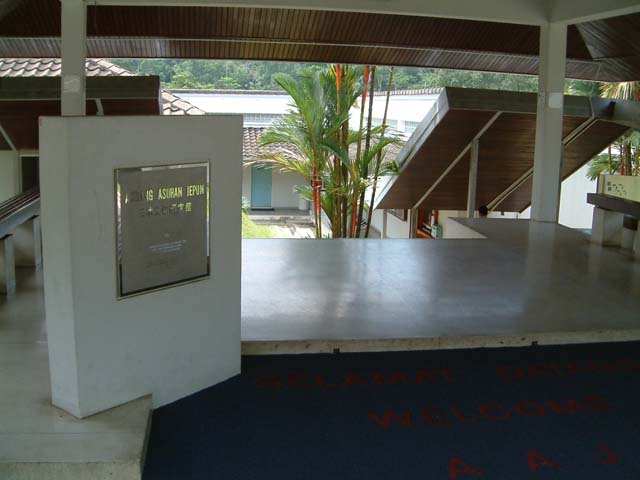 |
| A.A.J. school building entrance |
| It says "Japanese Culture Research Society" |
 |
 |
| A.A.J. school building entrance |
| It says "Japanese Culture Research Society" |
| No | Table of contents |
| āP | Ā@Background to the Launch of This Course |
| āQ | Ā@Japanese Cooperation |
| āR | Ā@Change in Enrollment Capacity |
| āS | Ā@Purpose of This Preparatory Education |
| āT | Ā@Subjects to Be Taken |
| āU | Ā@Curriculum Table |
| āV | Ā@āQnd Grade Class Composition And Number of Students |
| āW | Ā@Regular Exams , Etc. |
| āX | Ā@Daily Schedule |
| āPāO | Ā@Weekly Class Timetable |
| āPāP | Ā@Dealing with the Sudden Full 2 Days Off per Week |
| āPāQ | Ā@2004 Teaching Content for Each Subject |
| āPāR | Ā@About Math Class |
| āPāS | Ā@2004 Sophomore Annual Event Plan |
| āPāT | Ā@Anual Events |
| āPāU | Ā@Parent/Guardian Interview |
| āPāV | Ā@Career Paths of Graduates |
| āPāW | Ā@Number of International Students Coming to Japan |
| āPāX | Ā@Break |
| āQāO | Ā@Holidays Not Found in Japan |
| āQāP | Ā@Back to Menu |
| Ā°In November 1981 , at the request of Prime Minister Mahathir , the Malaysian
government approached the Japanese government through Japanese embassy
regarding the Malaysian government's plan for undergraduate students. Ā°Behind this concept is the Look East Policy announced by former Prime Minister Mahathir in December of the same year. In other words , rather than focusing on Western Europe , we will turn our attention to the eastern countries such as Japan and South Korea , which have achieved rapid development , learn their work ethics , economic philosophy and technology , and try to accelerate the industrial moderization and development of Malaysia. In particular , former Prime Minister Mahathir expressed his strong expectations for human resource development in Japan , stating "We decided to go to Japan in search of ethics and knowledge." Ā°In response to this initiative , the Ministry of Education at the time told the Malaysian government that it would cooperate as much as possible if it had a stable plan that would allow excellent syudents to be dispatched over a long period of time. It also said that in order to materialize the concept , it is necessary to make preparations through consultations between the governments of the two countries. Ā°In the spring of 1982 , five months after the consultation , the Japanese government dispatched three Japanese language education specialists from the Japan Foundation. Preparations were mostly completed on the Malaysia side , and undergraduate preparatory education for international students started at the University Malaya Preparatory Education Department and Malaya National University Preparatory Education Department with 42 students in the first batch. Ā°The preparatory education for the second and subsequent students was changed to be conducted at one preparatory education department of University Malaya , which continues to this day. |
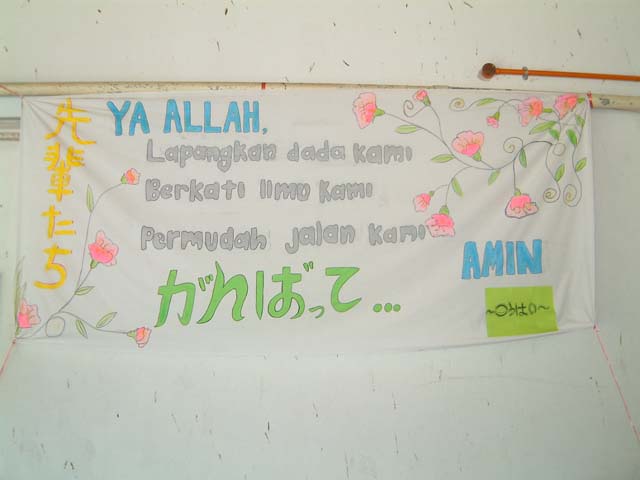 |
| Handmade Encouragement Banner. A.A.J. 1st Grade Sent It to 2nd Grade. |
| On the day of the Ministry of Education , Culture , Sports , Science , and Technology Exam , it was put up in the A.A.J. school building. (1/10/2005) |
| Ā°The exiting facilities was constructed between 1982 and 1983 under Japanese grant aid , and consists of 2 audiorooms , 6 small classrooms , LL classroom , and a teacher's office buildings. The total amount of aid , including related equipment , is approximately 390 million yen. Ā@Since the facilities became too small , Japan's grant aid (approximately 380 million yen) was introduced again to expand the facilities , and the construction was completed at the end of 1989. Ā°Teachers are divided into subject teachers and Japanese language teachers. Ā@The subject teachers are dispatched from the Ministry of Education , Culture , Sports , Science , and Technology ,and their term of office is two years in principle. Textbooks are also provided by the Japanese side. Ā@Thirteen Japanese language teachers are dispatched from the Japan Foundation. Ā@In principle , the term of office is two years , but there are many who serve for three years. Since dispatched teachers alone can not cope with the increase in the number of students , we have 2 locally hired full-time Japanese teachers , 5 local teachers , and 4 part-time teachers , for a total of 24 people. The textbooks used are to be purchased by the university. Ā°Regarding university admission , the Japanese Ministry of Education , Culture , Sports , Science , and Technology decides which university to enroll in , taking into consideration the applicant's field of interest and the desire to be accepted by a Japanese university. Ā°All students who have decided to study in Japan become Malaysian government-sponsored international students , and about 10 of them each year are accepted as government-spnsored international students by the Japanese government. |
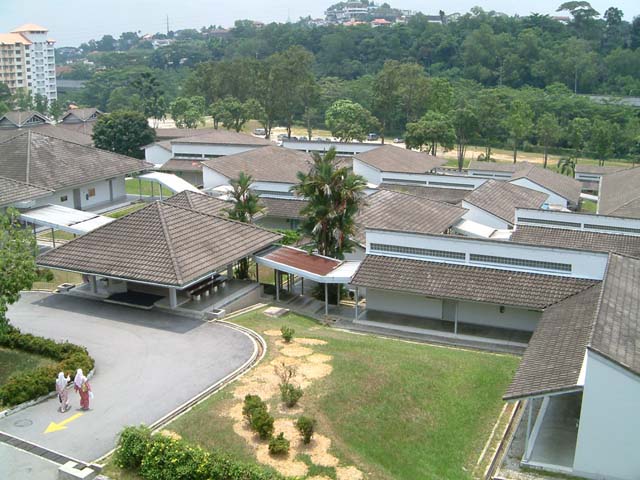 |
| National University Malaya Preparatory Education Department Special Course for Study in Japan (A.A.J.) School Building |
| It is called the "Japanese Culyure Research Center" |
| Year of change | Student | Capacity | Remarks |
|---|---|---|---|
| 1982 | 1st | Ā@75 | Natural science 50ĀCSocial science 25 |
| 1985 | 4th | 100 | Natural science 75ĀCSocial science 25 |
| 1991 | 10th | 120 | Natural science 90ĀCSocial science 30 |
| 1992 | 11th | 140 | Natural science 110 (Includes biology course 20)ĀCSocial science 30 |
| 1994 | 13th | 160 | Natural science 130 (Includes biology course 20)ĀCSocial science 30 |
| 1999 | 18th | 160 | Natural science 160 |
| 2003 | 22nd | 180 | Natural science 180 |
| 2005 | 24th | 160 | Natural science 160 |
| Ā@Entrants are selected and determined by Malaysian government Personel
Authority and University Malaya from among those who have passed the academic
achievement test (SPM) held in the second year of high school. |
 |
| 2005Āi23rdĀj2nd Grade Opening Ceremony |
| At the beginning of the ceremony , the president of the student council leads a prayer. |
| Ā°It targets Malaysian students selected by the Malaysian government in
line with the intent of the Look East Policy promoted by the Malaysian
government. It provides Japanese language and subject education as preparatory
education for admission to Japanese universities and departments. Ā°The period of education will be two years , during which students will acquire the Japanese language proficiency and accademic skills related to major basic subject (Academic ability equivalent to a Japanese high school graduate) that will allow them to study at a Japanese university or department as smoothly as possible. |
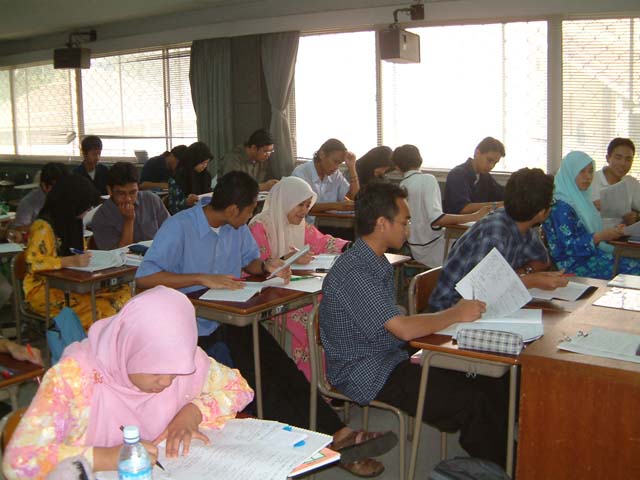 |
| A.A.J. 2nd Grade Mathematics Class Is Conducted in Japanese. |
| Textbooks and workbooks are those used in Japanese high schools. |
| Ā@Students learn Japanese only in their first year at A.A.J. , and in their
second year , they are able to listen to and understand math , physics
, and chemistry classes in Japanese. |
| ĀÉ1st yearĀĄ Ā@Ā@Ā@Six subjects: Japanese , mathematics , physics , chemistry , English , and Japanese affairs ĀiAll classes are taught in English except Japanese.Āj ĀÉ2nd yearĀĄ Ā@Ā@Ā@Six subjects: Japanese , mathematics , physics , chemistry , English , and Japanese affairsĀiAll classes are taught in Japanese except English.Āj |
| 1st year | |||||
| Ā| | Class hour per week | Ā| | |||
| Subject | SemesteráT | SemesteráU | A year | ||
| Japanese | āQāO | āQāO | āQāO | āQāO | āTāWāW |
| Mathematics | āO | āU | āO | āU | āPāUāP |
| Chemistry | āO | āU | āO | āU | āPāVāQ |
| Physics | āO | āT | āO | āT | āPāTāO |
| English | āO | āR | āO | āR | āVāU |
| Japanese affairs | āO | āP | āO | āP | āQāT |
| Total | āQāO | āSāP | āQāO | āSāP | āPāPāVāQ |
| Ā¶Ā@ārāÖāćāÖāďāĒāÖāíáTis 16 weeks , ārāÖāćāÖāďāĒāÖāíáUis 15 weeks , and one class hour is 50 minutes. (2005) |
| 2nd year | |||||
| Ā| | Class hour per week | Ā| | |||
| Subject | SemesteráV | SemesteráW | A year | ||
| Japanese | āPāQ | āPāQ | āPāQ | āPāQ | āRāTāV |
| Mathematics | āW | āV | āW | āV | āQāOāS |
| Chemistry | āW | āV | āW | āV | āQāOāT |
| Physics | āW | āV | āW | āV | āQāOāS |
| English | āO | āR | āO | āR | āUāS |
| Japanese affairs | āP | āP | āP | āP | āQāV |
| Total | āRāV | āRāV | āRāV | āRāV | āPāOāUāP |
| Ā¶Ā@ārāÖāćāÖāďāĒāÖāí áVis 15 weeks , ārāÖāćāÖāďāĒāÖāí áWis 16 weeks , and one class hour is 50 minutes. (2005) |
| āPĀDIn the first year , classes are conducted in English except for Japanese.
(Malay was used in classes until the 2005 admission students) āQĀDIn the second year , classes are conducted in Japanese except for English. The left and right colums of semester áV and semester áW represent weeks without English classes and weeks with English classes , respectively. āRĀDChemistry and physics are taken in natural science courses. āSĀDFrom 1993 to 1999 , there were a biology course , and chemistry and biology were taken in the second year , but it is not being implemented now. āTĀDThe natural science course is a preparatory course for engineering , medicine , dentistry , and agriculture. The social science course was a preparatory course for the Facluty of Economics , Faculty of Business Administration , and Faculty of Commerce. āUĀDFrom the 1998 academic year , recruitment for the social science course was stopped , and only the natural science course was accepted. |
| Ā°The classes consist of G1(29 people) , G2(29 people) , G3(28 people) ,
G4(29 people) , G5(29 people) , and G6(28 people). Ā°The number of students by gender is 135 boys and 38 girls. Ā@The above is for the academic year 2005. |
| Ā@There are two semesters , and midterm and final exams are held in each
semester. However , in SemesteráW , the Ministry of Education , Culture
, Sports , Science , and Technology exam will be conducted , so neither
the midterm exam nor the fial exam will be conducted. Ā@The first half of the first year is called "SemesteráT" , the second half of the first year is called "Semester áU" , the first half of the second year is called "Semester áV" , and the second half of the second year is called "Semester áW" |
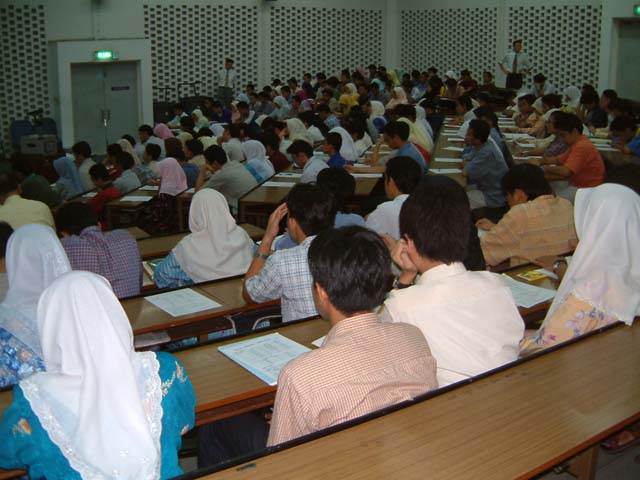 |
| SemesteráVMidterm Exam Briefing |
| The exam schedule , exam venue , notes on the exam , and so on are explained. |
| 1st grader | |
| 1st period | āWĀFāOāOĀ`āWĀFāTāO |
| 2nd period | āXĀFāOāOĀ`āXĀFāTāO |
| 3rd period | āPāOĀFāPāOĀ`āPāPĀFāOāO |
| 4th period | āPāPĀFāPāOĀ`āPāQĀFāOāO |
| 5th period | āPāQĀFāPāOĀ`āPāRĀFāOāO |
| 6th period | āPāSĀFāOāOĀ`āPāSĀFāTāO |
| 7th period | āPāTĀFāOāOĀ`āPāTĀFāTāO |
| 8th period | āPāUĀFāOāOĀ`āPāUĀFāTāO |
| 9th period | āPāVĀFāOāOĀ`āPāVĀFāTāO |
| 2nd grader | |
| 1st period | āWĀFāOāOĀ`āWĀFāTāO |
| 2nd period | āXĀFāOāOĀ`āXĀFāTāO |
| 3rd period | āPāOĀFāPāOĀ`āPāPĀFāOāO |
| 4th period | āPāPĀFāPāOĀ`āPāQĀFāOāO |
| 5th period | āPāQĀFāPāOĀ`āPāRĀFāOāO |
| 6th period | āPāSĀFāOāOĀ`āPāSĀFāTāO |
| 7th period | āPāTĀFāOāOĀ`āPāTĀFāTāO |
| 8th period | āPāUĀFāOāOĀ`āPāUĀFāTāO |
| 1st graderĀ@Regular timetable | |||||
| Ā| | Monday | Thuesday | Wednesday | Thirsday | Friday |
| 1st period | Mathematics | Mathematics | Japanese | MathĀ^PhysĀ^Chem | Japanese |
| 2nd period | Japanese | Chemistry | Japanese | Mathematics | Japanese |
| 3rd period | Japanese | PhysĀ^ChemĀ^Engl | Japanese | Chemistry | Japanese |
| 4th period | Japanese | PhysĀ^ChemĀ^Math | Japanese | Japanese | Japanese |
| 5th period | Japanese | PhysĀ^ChemĀ^Math | Physics | Japanese | Ā| |
| 6th period | ChemĀ^MathĀ^Phys | Japanese | English | Japanese | Ā| |
| 7th period | MathĀ^ChemĀ^Phys | Japanese | English | Japanese | Mathematics |
| 8th period | EnglĀ^PhysĀ^Chem | Japanese | Chemistry | Physics | PhysĀ^MathĀ^Chem |
| 9th period | Physics | Japanese | Physics | Chemistry | Ā| |
| 2nd graderĀ@Regular timetable | |||||
| Ā| | Monday | Thuesday | Wednesday | Thursday | Friday |
| 1st period | Japanese | Mathematics | Japanese | Chemistry | Physics |
| 2nd period | Japanese | Mathematics | Japanese | Chemistry | Physics |
| 3rd period | Physics | Japanese | English | English | Japanese |
| 4th period | Physics | Japanese | English | Mathematics | Japanese |
| 5th period | Extra Time | Extra Time | Chemistry | Mathematics | Extra Time |
| 6th period | Japanese affairs | Japanese | Chemistry | Physics | Ā| |
| 7th period | Chemistry | Physics | Mathematics | Japanese | Ā¶ |
| 8th period | Chemistry | Physics | Mathematics | Japanese | Ā¶ |
| Ā@However , the 7th and 8th periods on the 2nd and 4th Fridays are for Japanese
, and the 7th and 8th periods on the 3rd Fridays are for chemistry. Ā@Also , the 1st and 2nd periods on the 3rd Friday are for mathematics. Ā@From July 2005 , it became a full 2 days off per week. Ā@Extra time is used for make-up exams , supplementary classes , personal meetings , etc. |
| 2nd grader Special timetable | |||||
| Ā| | Monday | Thuesday | Wednesday | Thursday | Friday |
| 1st period | Japanese | Mathematics | Japanese | Physics | Physics |
| 2nd period | Japanese | Mathematics | Japanese | Physics | Physics |
| 3rd period | Chemistry | Japanese | Chemistry | Mathematics | Japanese |
| 4th period | Chemistry | Japanese | Chemistry | Mathematics | Japanese |
| 5th period | Extra Time | Extra Time | Mathematics | Chemistry | Extra Time |
| 6th period | Japanese affairs | Japanese | Chemistry | Chemistry | Ā| |
| 7th period | Physics | Physics | Mathematics | Japanese | Ā¶ |
| 8th period | Physics | Physics | Mathematics | Japanese | Ā¶ |
| Ā@However , the 7th and 8th periods on the 2nd and 4th Friday are for Japanese
, and the 7th and 8th periods on the 3rd Fridays are for chemistry. Ā@Also the 1st and 2nd periods on the 3rd Friday are for mathematics. Ā@From July 2005 , it became a full 2 days off per week. Ā@Extratime is used for make-up exams , supplementary classes , personal meetings , etc. |
| Ā@On June 17 , 2005 (Friday) , we suddenly heard that from July next month
, we will have a full five-day work week. For us , who are conducting classes
under the anuual plan , it came as a surprise. Ā@Until now , A.A.J.'s sophomores have had the 1st and 3rd Saturdays off. The 2nd Saturday , 4th Saturday , and 5th Saturday , which will be closed from July , will also be included in the annual plan. Saturday is closed , and it is necessary to hold Saturday classes that can not be done somewhere from Monday to Friday. Ā@We decided to allocate one hour each of the 2 hours of mathematics and 2 hours of chemistry that were on Saturday in the timetable to the extra time of the 5th period (12:10 to 13:00) every Wednesday and Thursday. (Usually , extra time is time used for personal interviews , supplementary examinations , re-examinations , and the like) |
| ĀÉJapaneseĀĄ Ā@Japanese instruction is provided in the 1st and 2nd yeaes. Ā@The purpose is to facilitate daily life and school life while studying in Japan , and to enable smooth attendance of lectures after entering the undergraduate school. Ā@In the 1st year , the basics of Japanese languages proficiency are taught , and students also learn about the basic lifestyle and culture of Japanese people through learning conversational expessions. Ā@In the second year , students are taught expressions centered on intermeditate-level written language. Beginning with simple explanations and editionals , using Japanese texts , critiques , newspaper articles , etc. as materials , think about Japanese life and culture , modern society and science , express opinions , write , and critique. Instruction is given so that. Ā@Guidance from 1st year to 2nd year includes teaching the conversation skills necessary to build human relationship in Japan , reading comprehension skills in higher education , writing skills necessay for submitting reports , etc. Content is transferred. Ā@On the other hand , in the final stage of the 1st year , the immediate goal is to learn the sentence patterns and vocabulary necessary for the basic subjects of mathematics , physics , and chemistry that begin in the 2nd year in Japan. Ā@In order to achieve the above goals , the Japanese language course as a whole has a meticulous curriculum . However , due to the lack of study time and the fact that the students are non-kanji-based , it is debated whether they are getting close enough to their goal. Also , in order to achieve the above goals , there is always a discussion about where to place the final goal within the given conditions. Ā@Is it enough to nurture basic skills and bet on students' applied skills ? Is it enough to pull students up to the level of Japanese required immediately after entering the undergraduate school ? We are haunted by these two dilemmas. Ā@Classes for Japanese language classes are divided into groups according to ability based on the results of regular examinations , expect for immediately after enrollment. |
| ĀÉJapanese affairsĀĄ Ā@Malaysian government-sponsored students will be placed at universities in various places soon after arriving in Japan. They need to adjust to community life as soon as possible and have a healty and meaningful university life. Basic matters such as the climate , lifestyles , systems , industries , and university education that are markedly different from those in the home country will be explained. In class , books written in Japanese for Japanese readers are used as texts. In order to help the audience's understanding , OHP sheets summarizing important matters and various video teaching materials are used for instruction. |
| ĀÉMathematicsĀĄ Ā@1st-year students are taught in Malay by local staffs. The course content includes not only the content coverd in Japanese high schools , but also the content of university education , and teaches a wide rage of mathematics in general. In the 2nd year , we mainly focus on calculus and integral , and teach the follwing contents in Japanese. Specifically , we teach using textbooks written in Japanese , practice using work books written in Japanese , and conduct confirmation tests after each unit. After the break (short-term holiday) , we conduct a task test. Ā@ĀEfunctionĀiMapĀAquadratic functionĀAtrigonometric functionĀAexponential functionĀAlogarithmic functionĀAfractional functionĀAirrational functionĀj Ā@ĀEproposition , proof Ā@ĀEvector Ā@ĀElimit , series Ā@ĀEdifferentiation and its applications Ā@ĀEintegral and its applications Ā@ĀEcomplex number plane , Taylor expansion , differential equations (Teached after MEXT test) Ā@In addition , handling of numbers , probability , numbers and formulas , squences , plane geometry , figures and equations , and all fields of mathematics C are not taught in the 2nd year. |
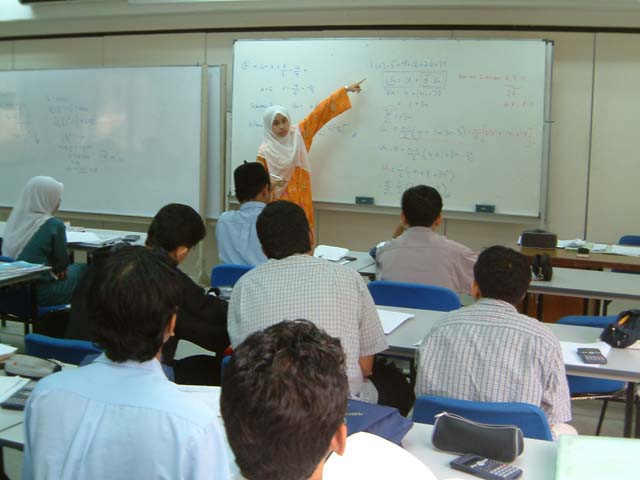 |
| Mathematics Class by Local Staff |
| A.A.J. 1st grade mathematics class is conducted in English. |
| ĀÉPhysicsĀĄ Ā@1st-year students are taught in Malay by local staffs. The contents of the class are physics in general , and experiments are included. In the 2nd year , special emphasis is placed on mechanics and electromagnetism. In addition , we are working to improve calculation ability , comprehension of Japanese , and logical thinking. The following contents are taught in Japanese. A comfirmation test after each unit and a task test after a break (short holidays) are conducted. Ā@ĀEMotion of object Ā@ĀEMotion of fallinng object Ā@ĀEForce and balance Ā@ĀELow of motion Ā@ĀEConservation of mouentum Ā@ĀEWork and mechanical energy Ā@ĀEUniform circular motion , Simple harmonic motion Ā@ĀEElectrostatic force , Electric field , Potential Ā@ĀECondenser Ā@ĀECurrent Ā@ĀECurrent and magnetic field Ā@ĀEElectromagnetic induction |
| ĀÉChemistryĀĄ Ā@In 1st year , students are taught in Malay by local staffs. In the second year , classes are centered around Japanese rextbooks written in Japanese. For difficult words and phrases , Malaysian is also written side by side to aid understanding. The enphasis is placed on the "structure , state , and change of matter". From this year , a chemical terminology test is being conducted to ensure that the knowledge is established. In addition , supplementary examinations and supplementary lessons are given to those who lack understanding as necessary. A comfirmation test is given after each unit , and a task test is given after the break (short holiday). |
| Ā@Education in Malaysia consists of 6 years of elementary school , 3 years
of junior high school , 2 years of high school , 1 year of college preparatory
education (2 years of A.A.J.) , and 4 years of university. Ā@I teach 2nd-year students in this preparatory education. In two years of high school and one year of preparatory education , they have already learned the contents of the Japanese classifications of mathematicsáT, mathematicsā` , mathematicsáU , mathemmaticsāa , and mathematicsáV. Ā@From April to mid-July this year , the contents of mathematics instruction are maps , liner functions , quadratic functions , quadratic inequalities , fractional functions , irrational functions , exponential functions , logarithmic fanctions , sets and propositions , proofs , vector , sequence. These are the fields of Mathematics áT,áU,ā`, and āa. Since mid-July , we have been teaching Mathematics áV , Limits and Differentiation. Ā@There was a big difference in terms of retention and understanding between learning previously learned items in unfamiliar Japanese and learning new things in unfamiliar Japanese. Ā@In mathematics classes , we are keenly aware of the need for instruction that pays close attention to this fact. 8/1/2004 Written down Ā@From 2005 , A.A.J. 2nd grade students will take the Examination for Japanese University Admission for International Student (EJU). Until 2004 , all we had to do was prepare for the Ministry of Education , Culture , Sports , Science and Technology exams in January. However , EJU will be implemented in November , so it is two months earlier. Furthermore , the test coverage of EJU is about twice that of the Ministry of Education , Culture , Sports , Science and Technology exam. Ā@In the Department of Mathematics , a new curriculum has been created for EJU in November and has been implemented since 2005. Also , since late May 2005 , mathematics classes have been organized by proficiency level , which is the first trial of its kind. |
 |
| Japanese Company VisitĀiat the Panasonic FactoryĀj |
| After observing the TV assembly manufacturing process , at the general meeting ,explanations are given. |
| April | Ā@Japanese class start (4th) , Opening ceremony (25th) , Special class schedule
(26thĀ`) |
| May | Ā@Break (15th to 23rd) , Regular schedule (30thĀ`) , 1st indivisual interviiew (25th to June 10th) , Career preference Survey |
| June | Ā@Interm examination (21st to 24th) , 1st personal interview (May 25th to 10th) , Career preference Survey , EJU preminary guidance (27th) |
| July | Ā@EJU appliciation (4th to 29th) , Sports event (evening of 22nd) , Break (24thĀ`31st) |
| August | Ā@Meeting to listen to experiences of seniors (13th) , Final examination (26th to September 2nd) |
| September | Ā@Final examination (August 26th to 2nd) , Break (2nd to 11th) , Start of semesteráW/Special timetable (from 12th) , Visit to Japanese company (20th) , 2nd personal interview , Career aspiration survey , Exchange with KL Japanese school (30th) |
| October | Ā@Regular schedule (From 24th) , Break (26th to November 8th) |
| November | Ā@Break (October 26th to 8th) , Examination for Japanese University Admission for International Students (13th) |
| January | Ā@Ministry of Education , Culture , Sports , Science , and Technology(16th to 20th), Break (21th to February 5th) |
| February | Ā@Break (January 21st to 5th) , Farewel party (5th) , Special timetable (From 6th) , AAJ orientation (15th) , Completion ceremony (17yh) , PSD orientation (20th to 25th) |
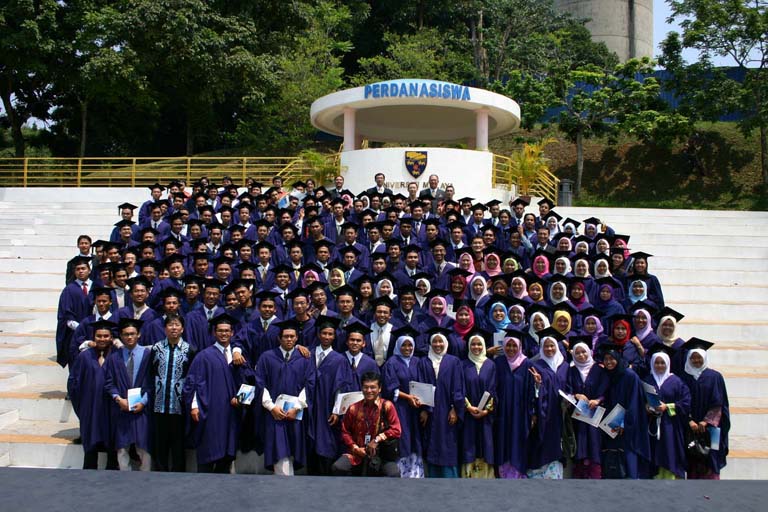 |
| 22nd Graduation Ceremony (2/15/2005) |
 |
| A Tug-of-War at a Very Exciting Sports Event |
| Ā°Sports compettionĀifor 1st and 2nd gradersĀj held from 17:00 to 19:00 August 8 (Friday) Ā@This event is held to welcome first year students and to promote friendship between students and staffs. Events include "tug-of-war" , "radio calisthenics" , "sandwich" , and "grab beans. |
| Ā°Listening to the experiences of seniors Āifor 2nd gradersĀj held from 15:30 to 18:00 August 15 (FridayĀj Ā@A.A.J. graduates who are currently working at major Japanese companies in Malaysia were invited. Then , we asked them to talk about their preparations for studying in Japan and their experiences of university life in Japan. |
| Ā°Japanese company factory tourĀifor 2nd year studentsĀj September 23 (Tuesday) 9:00 - 13:00 Ā@We visited a Japanese company and observed the actual situation of the company. By doing so , we are helping students to recognize the current state of production technology , deepen their understanding of the content of their duties , and develope their career awareness. After listening to an overview of the company , the students touched the TV assembly line , research and development room , and sales department. Destination: Panasonic AVC Network Kuala Lumpur Malaysia SDN.BHD |
| Ā°Exchange Meeting with KL Japanese School 4th graders Āifor 2nd graders who wish to attendĀj October 10th (Friday) 14:15 Ā` 16:20 Ā@It started last year in response to the āiārājāk(Japanese School of Kuala Lumpur) 4th graders' desire to deepen their understanding of Malaysia. It is also a good opprtunity for A.A.J. students to hear about Japanese children and talk about Japan. |
| Ā°Visiting a Japanese familyĀifor 2nd graders who wish to attendĀjOctober 11th ĀiSaturdayĀj14:00Ā`18:00 Ā@The purpose of this program is for students to visit Jaapanese families living in the suburbs of KL and experience the lifestyle of Japanese people and the atomosphere of a Japanese home. Accepting families are solicited by Japanese associations , Japanese newspapers , etc. Every year , 30 to 40 families accept them. In 2003 , 27 families cooperated and 84 students participated. They visited as a group of three. |
| Ā°Exchange meeting with Hyogo Prefectural Itami Kita High School (for 2nd
graders) held on Februay 4ĀiWednesdayĀj Ā@Through interaction with Japanese high school students , the purpose of this program is to practice Japanese conversation and increase motivation to study in Japan. Exchanges centered on free walking around the campus by group. |
| Ā°Others Ā@Bon dance compettion sponsored by the Japanese Association (for 1st and 2nd year students who wish to participate) , the Japanese Fondation Speech Contest , Post Letter Writing Contest |
| From the 2003 event |
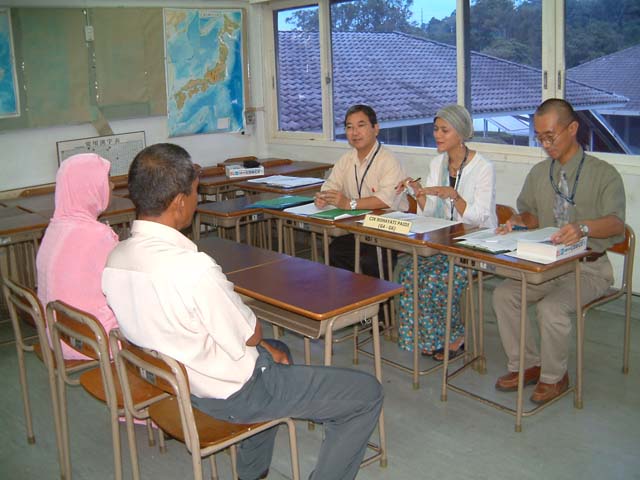 |
| Interwiew with Parents |
| Ā@On Sunday , August 21st , from 14:30 to 17:00 , a parent-teacher conference
was held for 1st-year and 2nd-year students of the Special Course for studying
in Japan (A.A.J.) , Preparatory Education Department , University , Malaya. Ā@Parents' conferences for 1st-year students had been held until last year , but this year was the first attempt for 2nd-year students. Ā@Open days , which are part of the 100th anniversary celebrations of the University Malaya , were held on Saturday , August 20th and Sunday , August 21st , during which parent-teacher conferences were arranged. Ā@Three interview venues were set up for 1st-year students and two interview venues were set up for 2nd-year students. Parents wishing to be interviewed waited outside the interview venue. Ā@There were various interviews , such as parents alone , students and their parents , and younger brothers and sisters. Many 2nd-year parents were worried abot wheather they would be able to go to Japan with their current grades , and whether they would be able to go to Japan with their current ability to speak Japanese. Ā@Parents of 2nd-year students were attended to by two staff members in charge of subjects (mathematics , physics , chemistry) , one staff member in charge of the Japanese language , and one Malay staff member in charge of the Japanese language. Two meeting rooms were set up. Malay saff members were in charge of interpreting between Malay and Japanese. Ā@The parent-teacher conference , which started at 14:30 , continued without interraption until 17:00 , the scheduled time. |
 |
| A Meeting to Listen to Experience from Senior A.A.J. Graduates. |
| Ā°The Ministry of Education , Culture , Sports , Science and Technology of Japan decides the destinations for students to go on to universities , taking into consideration the fields of interests of students and the wishes of universities. Including 172 students from the 22nd class who went to Japan in the spring of 2005 , the total number of students envolled so far is 2417. A total of 69 universities have accepted them from Hokkaido in the north to Okinawa in the south. However , under the policy of Malaysian government , the faculties where students can study abroad are , in principle , engineering faculties and medical faculties. Ā°Most of the students who have studied and graduated from Japanese national universities are now working in Malaysia. Destinations include Japanese companies , foreign companies , the government , and further education. However , it is difficult to follow up on them , and the Malaysian National Personnel Authority has not grasped the whole situation. Ā°Before deciding on a students' career paths , personal interviews with all staff in June and personal interviews with the homeroom teachers from September to October are held. Also , in August , we held a meeting to hear about the experience of seniors , and by hearing about their success in Malaysia and thier experiences studying abroad in Japan , we help them decide on their career paths. From the beginning of September , we started preparing the documents related to students' study abroad applications , and by the end of November , we sent them to the Japanese Ministry of Education , Culture , Sports , Science , and Technology. |
| Main career event | |
| June | Ā@1st personal interview |
| August | Ā@Meeting to listen to the experience of seniors, Career guidance session |
| September | Ā@2nd persanal interwiew , Career desire survey |
| October | Ā@Guidance on how to fill out necessary documents related to studying abroad , List of desired career paths |
| November | Ā@Completion of necessary documents related to studying abroad |
| Division | Year | Number of international students |
| 1st class | 1982Ā`1983 | 39 |
| 2nd class | 1983Ā`1984 | 45 |
| 3rd class | 1984Ā`1985 | 64 |
| 4th class | 1985Ā`1986 | 79 |
| 5th class | 1986Ā`1987 | 81 |
| 6th class | 1987Ā`1988 | 84 |
| 7th class | 1988Ā`1989 | 81 |
| 8th class | 1989Ā`1990 | 88 |
| 9th class | 1990Ā`1991 | 104 |
| 10th class | 1991Ā`1992 | 114 |
| 11th class | 1992Ā`1993 | 135 |
| 12th class | 1993Ā`1994 | 123 |
| 13th class | 1994Ā`1995 | 127 |
| 14th class | 1995Ā`1996 | 145 |
| 15th class | 1996Ā`1997 | 147 |
| 16th class | 1997Ā`1998 | 141 |
| 17th class | 1998Ā`1999 | 96 |
| 18th class | 1999Ā`2000 | 107 |
| 19th class | 2000Ā`2001 | 149 |
| 20th class | 2001Ā`2002 | 149 |
| 21st class | 2002Ā`2003 | 147 |
| 22nd class | 2003Ā`2004 | 172 |
| Total | Ā|Ā|Ā| | 2417 |
| Ā¶The table above shows the number of A.A.J. students who passed the Ministry
of Education , Culture , Sports , Science , and Technology exam and studied
at Japanese national universities. Ā¶All students who have decided to study in Japan , become Malaysian government sponsored international students , and about 10 of them are adopted as government-sponsored international students by the Japanese government every year. |
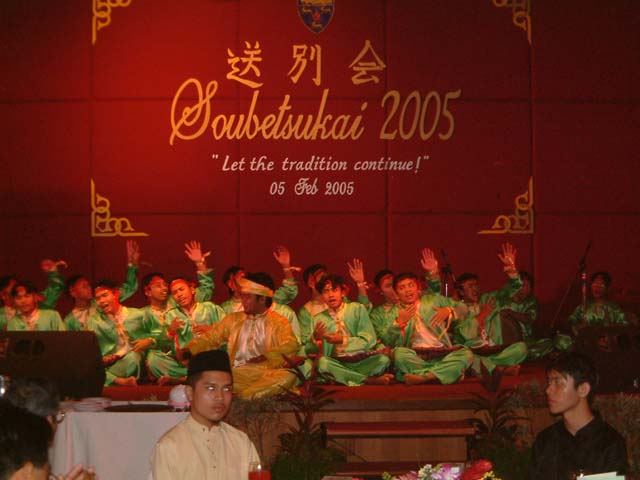 |
| Farewell Party for A.A.J. 2nd Year Students (2/5/2005)Ā@ĀEĀEĀE at a Hotel in the City ĀEĀEĀE |
| A.A.J. 1st year students are showing off the events that they have been practicing for this day. |
| Ā@The week from July 26th (Monday) to August 1st (Sunday) is called "Break"
, and there are no classes for students. In adittion , students are on
vacation. Teachers can also take annual leave. Ā@There is no long vacation like summer vacation in Japan. There is no winter vacation (New year's holiday). Instead , the breaks are May 17-23 , July 26-August 1 , Sept 6-12 , Nov 8-21 , Jan 20-Feb 2. There are a total of 5 times. Ā@The break schedule changes slightly each year. 8/1/2004 written. |
| April | Ā@Mohammed birthday (21st) |
| May | Ā@May Day (1st) , Buddaha's birthday (22nd) |
| June | Ā@King birthday (4th) |
| August | Ā@Independence day (31st) |
| November | Ā@Hindu Festival (1st) , Hari Raya Puasa (3rd , 4th) |
| December | Ā@Christmas (25th) |
| January | Ā@Hari Raya haji (10th) |
| February | Ā@ājākāĄāĀāô (1st) , Chinese New Year (9th , 10th) , Islamic new year (10th) |
| These are the public holidays in 2005. The date of the holidays changes from year to year. |